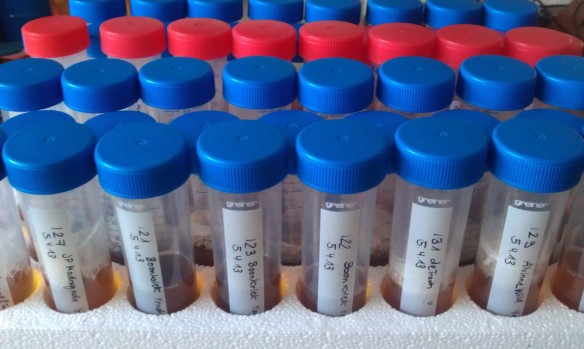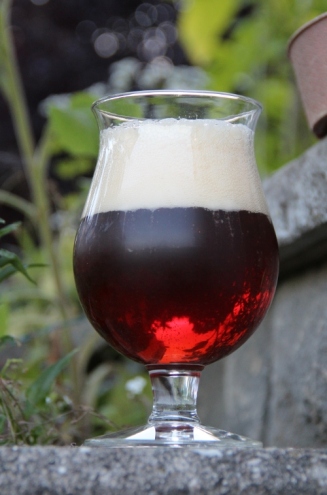Hello fellow yeast ranchers and Brett aficionados. Are you interested to be part of a large-scale Brettanomyces fermentation project? If yes, please read on. If not just ignore this post.
All started with the latest update of my yeast database which now consists of close to 100 isolated yeast and bacteria strains. After the last database update in mid June 2013, Bikes, Beer & Adventures (aka Jeffrey Crane) contacted me and asked for the strains to give me feedback in return. Since I haven’t actually brewed with any of the strains yet and kind of postponed the testing part for later on, we both agreed on an experimental setup to test all the different Brettanomyces strains in a single Brett-beer experiment. Jeffrey and I came up with a nice experiment to test some of the Brettanomyces strains I currently have.
 The basic idea for this experiment is to brew a rather simple beer, split the batch and ferment the split parts with individual Brettanomyces strains only. Then evaluate the outcome of the beers, evaluate the individual strains and return the results to me (or make them otherwise available to me like posting on a blog etc). The recipe for this experiment, developed by Jeffrey, is mentioned below.
The basic idea for this experiment is to brew a rather simple beer, split the batch and ferment the split parts with individual Brettanomyces strains only. Then evaluate the outcome of the beers, evaluate the individual strains and return the results to me (or make them otherwise available to me like posting on a blog etc). The recipe for this experiment, developed by Jeffrey, is mentioned below.
| Recipe: |
BBA/EBY-Brettanomyces Experiment |
|
| Numbers: | Volume [L] | 18 (5 gal) |
| Original gravity | 12.5°P (1.050) | |
| Terminal gravity | Will depend on strain used | |
| Color | Around 10 EBC | |
| IBU | 25 IBU | |
| ABV | Will depend on strain used | |
| Grains: | Pilsner malt (4 EBC) | 2.5 kg (5.5 lbs) |
| Munich malt (14.5 EBC) | 0.5 kg (1.0 lbs) | |
| Wheat malt (4 EBC) | 1 kg (2.0 lbs) | |
| Acid malt (5 EBC) | 0.17 kg (6 oz) | |
| Hops: | Styrian Goldings (4.5% AA) | Add 28.3 g (1 oz) and boil for 60 min |
| Saazer (4.5% AA) | Add 28.3 g (1 oz) and boil for 10 min | |
| Yeast: | EBY | Various strains in split-batch-mode |
| Water: | Mash: 10.4 L (2.75 gal), sparge: 19.8 L (5.2 gal) @78°C (172°F) | |
| Rest: | Mash in @67°C (152°F), 60 min @67°C (152°F), sparge at 74°C (165.2°F) | |
| Boil: | Boil for 60 min | |
| Fermentation: | Oxygenate your wort as normal | |
| Primary | 1-31 days at around 20°C (68°F) | |
| Secondary | 1-31 days | |
| Maturation: | Carbonation (CO2 vol) | 2 |
| Maturation time | N/A | |
How does the experiment work?
As a participant of the BBA/EBY Brettanomyces Experiment you will receive a small amount of the Brettanomyces strain(s) from me, propagate them to have enough yeast to pitch, follow the recipe and procedure mentioned above, split the batch and let the shares ferment with the Brett strains. Then evaluate the beers and give me feedback about the individual strains. After the experiment, you are free to keep the individual strains and use them as you like. One request though, please only subscribe to the experiment if you follow the recipe, procedure mentioned above. There will be time for individual tests later on.
What about the individual Brettanomyces strains?
The strains are all isolated from different sour beers by myself and haven’t been tested on full-scale yet. If everything works as planned the following 20 strains will be sent out:
EBY001 (B. girardin I), EBY002 (B. dreifonteinii I), EBY005 (B. cantillon I), EBY007 (B. italiana I), EBY008-013 (B. cantillon II to VII), EBY014-015 (B. lostfontain I and II), EBY016-017 (B. lambeek I and II), EBY019 (B. cucurbita I), EBY020 (B. jurassienne), EBY021 (B. bruery I), EBY035 (B. cucurbita II), EBY038 (B. cantillon VIII) and EBY048 (B. italiana II).
For more information about the individual strains check out my page with all the strains I currently have (go to EBY program).
- I will either send you the entire set of Brettanomyces (around 20 strains) or a subset of them. Please notice that I can only send out 8 complete sets of Brettanomyces (8 samples of each strain)
- Yeasts will be sent to you in 1.5 mL Eppendorf tubes (1 mL of liquid culture) and I only charge the shipping costs
- A 200 mL unstirred dry malt extract starter (20 g of DME to 200 mL of water) should be enough to get you enough yeast to ferment 2 L of wort (0.52 gal). I recommend to start the yeast starters three weeks before the brew day. If possible, sterilize your yeast starters using a pressure cooker as it might take more than a week before any signs of fermentation are visible. Brettanomyces grow really slow. If the yeast starter is not sterile, any contamination can easily out compete the slow-growing yeasts
- If you send me some interesting yeast/dregs in return, I will send you the Brettanomyces strains for free
- I will send out the yeasts somewhere between mid to end of August 2013
How can I participate?
Please only participate if you follow the recipe, procedure mentioned above. The whole purpose of this experiment is to get as much information about the strains as possible.
Please further notice that I haven’t tested most of the Brettanoymces strains on full-scale yet. I therefore cannot make any predictions about the fermentation performance nor the aroma, flavor profile of the out coming beers. I wouldn’t be surprised if there are strains not suitable for fermenting beers.
- First, go to http://doodle.com/hc2tgynku7khf8s8 and choose the yeast strain(s) you want to test. Please notice that I only send out eight samples of each yeast strains. I kindly ask you to only choose the yeast strains you are actually going to test
- If you are interested in the strains but don’t want to participate in this experiment, please subscribe to https://groups.google.com/forum/#!forum/eureka-brewing-yeast to get email alerts of future strain releases
- Second, write me an email to contacteurekabrewing@gmail.com with your shipping address and your name you used in the doodle list
- Third, the world-wide shipping costs (yes, I ship the stuff around the globe) for all the 20 yeast strains should be less than 20 USD (a rough estimate). However, I will charge you only the costs I actually paid at my post office in the end. To make my life easier, I would like to deposit all the parcels at my post office (by mid to end of August 2013) and then send you the quotes I had to pay afterwards. I therefore can’t tell you the exact shipping cost before the actual shipping
- And finally, payments can be done using Paypal (please add another 1 USD to cover the fees) or directly to my Swiss bank account
I would be really happy to get as much collaborators as possible. So please spread the word. If there are more collaborators out there than yeast strains, or the available yeasts are gone within an instant, I might even think about another re-release of yeast strains.
If anything is not clear feel free to comment below or write me an email to contacteurekabrewing@gmail.com.
I am really looking forward to this experiment which will hopefully be fun, exciting and a real adventure. Cheers, Sam



